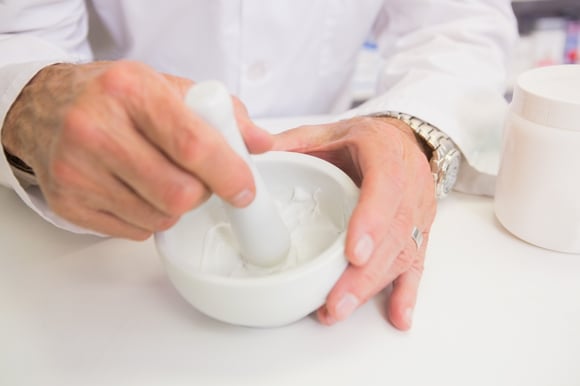Topical Compound Medications: An Alternative to Oral Medications

Topical compound medications are typically not the first choice for treatment of pain from a workplace injury, but they can be useful in some situations.
What is a Compound Medication?
A compound medication is created specifically for an individual when their medication needs cannot be met by commercially available manufactured products.
The U.S. Food and Drug Administration (FDA) states, “In general, compounding is a practice in which a licensed pharmacist, a licensed physician, or, in the case of an outsourcing facility, a person under the supervision of a licensed pharmacist, combines, mixes, or alters ingredients of a drug to create a medication tailored to the needs of an individual patient.”
Each compound medication is made for a specific individual need and are not FDA-approved commercially available products. When compound medications are made, the compounding pharmacy must follow specific statues and regulations that govern compounding in their state. Additionally, the United States Pharmacopeial (USP) Convention issues standards that apply to compounding. The USP is an organization that sets standards for the identity, strength, quality, and purity of medicines which are enforceable in the United States by the FDA. USP has standards for both sterile and nonsterile compounding. If a compound needs to be made as a sterile product (where microbial contamination could be significantly harmful such as a products intended for the eye, or injection into body) there are more stringent controls than for nonsterile compounding. Topically applied compounds (which are applied to a surface area like the skin) classically fall under the category of nonsterile compounding. According to American Chronic Pain Association, the most common compounded medications are topical medications.
Why Use a Compound Medication?
Compounded products may be needed when someone can’t take a commercially available product that may be helpful to them. For example, if a patient has an allergy to a dye or ingredient in a commercially available product, they may need a compound product specifically made without the dye or ingredient. Or, if a patient cannot ingest medication in its commercially available form, compound medications could be specifically customized to supply medication to the patient in a way that will fit their needs. For example, a specific pain cream or ointment compounded to be applied locally to a painful area may be used for a person that cannot swallow pain pills.
The Official Disability Guidelines (ODG), an evidence-based disability resource, mentions that compounded medications may be considered after an adequate trial of FDA-approved drugs has proven ineffective or are contraindicated for an individual patient. Topical pain compound medications may be utilized for nerve pain when the use of other, more predominant medications, such as antidepressants or anticonvulsants, has not worked. Providers may also prescribe a compound medication in an effort to avoid or reduce opioids for a particular patient. There has been a recent push to reduce unnecessary opioid exposure, as highlighted by recent public safety reports surrounding the opioid epidemic.
Topical compounds may have a role in treating pain for injured workers with a specific need. If a topical compounded medication is part of a treatment plan, follow up to asses and document if it is effective, if there is functional improvement and/or decreased use of other pain medications to support continued use for the patient from a safety, efficacy and cost standpoint is essential.
Other Posts You Might Be Interested In
Subscribe to email updates
Stay up-to-date on what's happening at this blog and get additional content about the benefits of subscribing.


